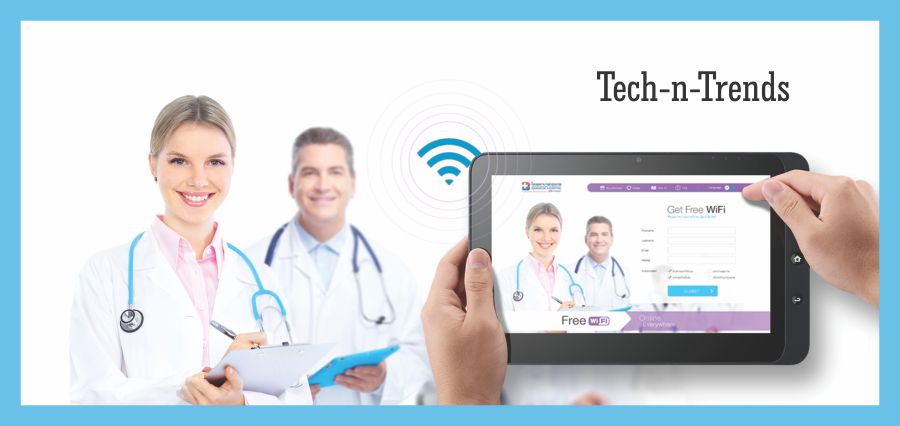Wi-Fi is the foundation for digital transformation in the healthcare industry. The Wi-Fi based healthcare service sector is predicted to reach a whopping $33.6 billion by 2020 globally. Healthcare industry has changed significantly in accordance with the technological advancements, including its relationship with Wi-Fi. The demand for Wi-Fi technology is rapidly increasing as doctors, nurses and other medical professionals increasingly use Wi-Fi-enabled devices, ranging from smartphones to patient monitors, in their daily responsibilities. Wi-Fi access helps medical professionals to access real-time information and patient records.
Following are some of the ways in which Wi-Fi is transforming healthcare:
Efficient Workflow
Nearly all healthcare professionals are required to be highly mobile. In a wireless environment, staff is no longer restricted by the wired workstations and can freely move from place to place and task to task without interruptions. This enables them to monitor patient vital signs through the use of mobile devices that are connected to the hospital network. Incorporating such practices simplifies the internal exchange of data and the recording of health-related patient data.
Data Transmission
Wi-Fi enables transfer of data from and to anywhere in the hospital and that too at a lightning fast speed. Doctors benefit immensely from this as they can access patient information faster and can relay an appropriate cure immediately. Wi-Fi can also be used to deliver highly targeted and patient-specific information such as vaccination reminders, repeat prescription information, follow-up appointment dates and special offers to the patients.
Furthermore, Electronic Health Records (EHRs) digitally stores all health-related data and can be shared by the doctors across diverse locations like patient rooms, treatments room and even in the operating theatre. The same is true for mobilization of diagnostic equipment. The static devices can be integrated into the hospital network via Wi-Fi to make them mobile and thus reduce the need to purchase multiple devices.
Feedback on Services
In healthcare sector, where everything is driven by targets and patient satisfaction, it is important to receive meaningful feedback. Useful feedback ensures that all the medical center staff is aware of patient views and can continue to deliver the best service possible. A healthcare center might get feedback information on how easy it was to book an appointment, what patients think of the care they received, and whether they needed a repeat appointment. Healthcare centers can ask for feedback on services via their Wi-Fi service whilst the patient is waiting for their appointment.
Remote Consultations
Appointments between doctors and patients with non-emergency conditions can be carried out using video conferencing software. Wi-Fi allows medical professionals in possession of a mobile device to meet their appointment schedule even when they are not physically present on-site. The benefits of this are wide ranging, from saving valuable practice budget to boosting patient satisfaction.
Medical Advances
Wi-Fi is not just useful for the patients. It is also being used for monitoring oxygen devices, smart beds, access to electronic medical records, and real-time access to X-rays and MRI scans. Such connectivity provides the users with anytime-anywhere access and allows clinicians to provide accurate and timely patient monitoring and focus on the best quality of patient care rather than just administrative tasks.
Guest Wi-Fi
Enabling guest Wi-Fi for patients and visitors will mean that outpatient wait times can be put to good use, and inpatients can stay connected to friends and family more easily. Healthcare organizations can also update caretakers with the latest information directly to their connected mobile devices, as well as enable services such as self-check in, all of which can help to streamline workflows while improving patient experience.
Smart Resource Allocation
Healthcare professionals, while trying to make the patient experience as smooth as possible remains conscious of the expenses involved in allocating resources. It is of course important to bear the expenses in mind and ensure that services are implemented and used in an effective manner. In this regard, Wi-Fi technology can be used to track wheelchairs, allowing staff to locate them easily and reducing instances of equipment going missing. Presence analytics can also identify which rooms are being used the most, so the hospital can adjust accordingly.
The possibilities are endless and the future for healthcare providers is a plethora of opportunity for enhanced communication from the provision of Wi-Fi.

Insights Success stands as the epitome of trust and authority. It has earned its reputation as the foremost source of business intelligence, providing readers with a gateway to the pulse of Bharat’s advancing business landscape.
Quick Links
Enquiry
info@insightssuccess.in
for more information on advertising opportunities with Insights Success magazine.
8793630422 / 24
Reach out to Us
Insights Success Media and Technology Pvt. Ltd.
512, Brand Square,
Kunal Icon Rd, Pimple Saudagar,
Pune, Maharashtra 411027

